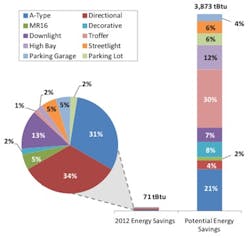DOE report estimates savings for use of LEDs in common lighting applications
Washington, DC--The U.S. Department of Energy (DOE) has released a report analyzing markets where light-emitting diodes (LEDs) compete with traditional lighting sources (for example, incandescent and fluorescent). The report, "Adoption of Light-Emitting Diodes in Common Lighting Applications," provides estimates of current energy savings, as well as potential savings if these markets switched to LEDs overnight.
Nine markets were analyzed:
--Four indoor lamp applications (A-type, directional, MR-16, and decorative)
--Three indoor luminaire applications (downlight, troffer, and high-bay)
--Two outdoor luminaire applications (streetlight and parking lot/garage).
In addition, if these nine markets switched to LEDs overnight, annual source energy savings could approach 3,873 tBtu, or about 3.9 quadrillion Btu (quads), saving nearly $37 billion in annual energy costs. This amount represents approximately half of the total national lighting energy consumption in 2012.
Related: 37 outdoor LED lamps recognized by U.S. DOE's 'Next Generation Luminaires' competition
Related: $4M DOE funding for LED manufacturing teams Veeco with Kyma
Related: Cause of LED efficiency droop experimentally pinpointed at last
The report notes that "the energy consumption and savings estimate results are highly sensitive to the state of LED
technology"; accordingly, it considered the best available existing LED technologies (see table below), rather than trying to do any projections based on upcoming but not yet available technologies.
For more information, or to download a PDF of the report, go to www.ssl.energy.gov/tech_reports.html.

John Wallace | Senior Technical Editor (1998-2022)
John Wallace was with Laser Focus World for nearly 25 years, retiring in late June 2022. He obtained a bachelor's degree in mechanical engineering and physics at Rutgers University and a master's in optical engineering at the University of Rochester. Before becoming an editor, John worked as an engineer at RCA, Exxon, Eastman Kodak, and GCA Corporation.

